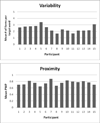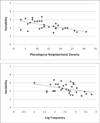Lexical and phonological effects in early word production
- PMID: 22207699
- PMCID: PMC3357200
- DOI: 10.1044/1092-4388(2011/10-0113)
Lexical and phonological effects in early word production
Abstract
Purpose: This study examines the influence of word frequency, phonological neighborhood density (PND), age of acquisition (AoA), and phonotactic probability on production variability and accuracy of known words by toddlers with no history of speech, hearing, or language disorders.
Method: Fifteen toddlers between 2;0 (years;months) and 2;5 produced monosyllabic target words varying in word frequency, PND, AoA, and phonotactic probability. Phonetic transcription was used to determine (a) whole-word variability and (b) proportion of whole-word proximity (PWP; Ingram, 2002) of each target word produced.
Results: Results show a significant effect of PND on PWP and variability (words from dense neighborhoods had higher PWP and lower variability than those from sparse neighborhoods), a significant effect of word frequency on variability (high-frequency words were less variable) but not proximity, and a significant effect of AoA on proximity (earlier acquired words had lower PWP) but not variability.
Conclusions: Results provide new information regarding the role that lexical and phonological factors play in the speech of young children; specifically, several factors are identified that influence variability of production. Additionally, by examining lexical and phonological factors simultaneously, the current study isolates differential effects of the individual factors. Implications for our understanding of emerging phonological representations are discussed.
Figures
Similar articles
-
Lexical and child-related factors in word variability and accuracy in infants.Clin Linguist Phon. 2013 Jul;27(6-7):497-507. doi: 10.3109/02699206.2012.752867. Epub 2013 Jan 22. Clin Linguist Phon. 2013. PMID: 23339451
-
Differentiating the effects of phonotactic probability and neighborhood density on vocabulary comprehension and production: a comparison of preschool children with versus without phonological delays.J Speech Lang Hear Res. 2010 Aug;53(4):933-49. doi: 10.1044/1092-4388(2009/09-0075). Epub 2010 Jun 11. J Speech Lang Hear Res. 2010. PMID: 20543024 Free PMC article.
-
Influence of phonotactic probability/neighbourhood density on lexical learning in late talkers.Int J Lang Commun Disord. 2013 Mar-Apr;48(2):188-99. doi: 10.1111/j.1460-6984.2012.00198.x. Epub 2012 Nov 9. Int J Lang Commun Disord. 2013. PMID: 23472958 Free PMC article.
-
Relationships between lexical and phonological development in young children.J Child Lang. 2011 Jan;38(1):1-34. doi: 10.1017/S0305000910000425. Epub 2010 Oct 18. J Child Lang. 2011. PMID: 20950495 Review.
-
The development of a vocabulary for PEEPS-SE-profiles of early expressive phonological skills for Swedish.Clin Linguist Phon. 2018;32(9):844-859. doi: 10.1080/02699206.2018.1445780. Epub 2018 Apr 10. Clin Linguist Phon. 2018. PMID: 29634359 Review.
Cited by
-
Practice and experience predict coarticulation in child speech.Lang Learn Dev. 2021;17(4):366-396. doi: 10.1080/15475441.2021.1890080. Epub 2021 Apr 6. Lang Learn Dev. 2021. PMID: 34483779 Free PMC article.
-
Phonological code retrieval during picture naming: Influence of consonant class.Brain Res. 2016 Mar 15;1635:71-85. doi: 10.1016/j.brainres.2016.01.014. Epub 2016 Jan 19. Brain Res. 2016. PMID: 26801830 Free PMC article.
-
Speech Intervention Outcomes Associated With Word Lexicality and Intervention Intensity.Lang Speech Hear Serv Sch. 2019 Jan 28;50(1):83-98. doi: 10.1044/2018_LSHSS-18-0026. Lang Speech Hear Serv Sch. 2019. PMID: 30453331 Free PMC article.
-
Are Late Talkers Just Late? Neighborhood Density and Word Frequency Properties of Late Talkers' Spoken Vocabularies.J Speech Lang Hear Res. 2024 Oct 8;67(10):3794-3802. doi: 10.1044/2024_JSLHR-23-00769. Epub 2024 Sep 20. J Speech Lang Hear Res. 2024. PMID: 39302886 Free PMC article.
-
Effects of a naturalistic intervention on the speech outcomes of young children with cleft palate.Int J Speech Lang Pathol. 2020 Oct;22(5):549-558. doi: 10.1080/17549507.2019.1702719. Epub 2020 Mar 12. Int J Speech Lang Pathol. 2020. PMID: 32164442 Free PMC article. Clinical Trial.
References
-
- Aslin RN, Saffran JR, Newport EL. Computation of conditional probability statistics by 8-month-old infants. Psychological Science. 1998;9:321–324.
-
- Barry C, Johnston RA, Wood RF. Effects of age of acquisition, age, and repetition priming on object naming. Visual Cognition. 2006;13:911–927.
-
- Beckman ME, Edwards J. Lexical frequency effects on young children’s imitative productions. In: Broe MB, Pierrehumbert JB, editors. Papers in Laboratory Phonology: Vol. V. Cambridge: Cambridge University Press; 2000. pp. 208–218.
Publication types
MeSH terms
Grants and funding
LinkOut - more resources
Full Text Sources



